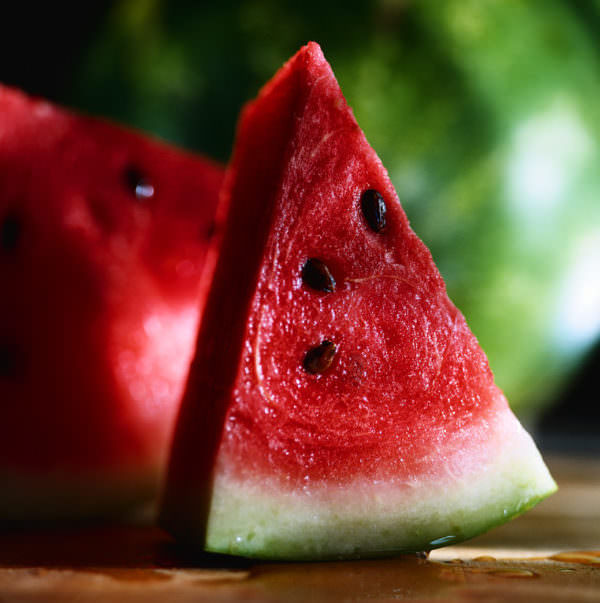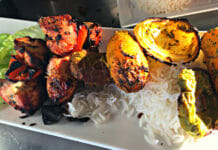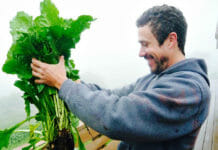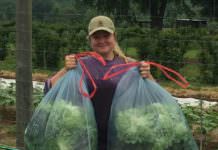
by guest blogger Rich Baringer
It’s just about time for watermelons to start appearing in our local farm markets. In many ways, watermelon seems like the all-American fruit—a staple at our summer picnics. It actually originated in Africa where it was cultivated by the Egyptians. It wasn’t until the 1600’s that it was introduced to the rest of the world. Today, there are about 1200 varieties of the fruit.
First, let me admit that I’m not usually a big fan of watermelon. The reason, though, is because it’s so rare that you actually taste one that is sweet and juicy and refreshing. So many times, watermelons are bland and taste like, well, water. A really ripe and flavorful melon is a different story.
Picking the best watermelon
So how do you avoid picking out a melon that is going to disappoint your picnic guests?
I’m sure you’ve heard about smelling or thumping or squeezing—everything short of using a stethoscope—none of which really work. I recently read an article where this same question was asked of an expert: Darryl Mosher, a farmer and professor at the Culinary Institute of America.
The first thing you should do is look at the melon’s shape. It should have a symmetrical shape. If not, it didn’t grow consistently and was probably “water-starved” at some point.
 Color is not an indicator of ripeness, although the rind should be bright, not dull-looking.
Color is not an indicator of ripeness, although the rind should be bright, not dull-looking.
What you should search for, however, is the “field spot.” This is the cream, yellow or orange spot where the melon sat on the ground.
This is an indication that the melon was allowed to ripen in the field. If there is a white or pale green spot—or if there isn’t one at all—move on to the next melon.
Another way to test juiciness and ripeness is to pick it up. Like many juicy fruits (citrus, for example), a watermelon should feel heavy for its size. That means it’s full of flavorful juice.
Also like many fruits and vegetables, the watermelon’s flavor and texture starts to decrease as soon as it’s picked, so buying locally means you’ll be getting a fresher, tastier melon.
We’re just at the beginning of watermelon season, depending on the variety, but melons should be showing up at markets very soon if they aren’t already. I just did a cooking demo at Blooming Glen Farm and a watermelon was part of their share.
Watermelons keep well in the refrigerator, but cold will eventually degrade the flavor and texture. It’s best to store it in a spot just below room temperature and refrigerate an hour or two before serving if you want a cold melon.
Mosher says that he likes his watermelon warm. He lets it sit out in the sun on his driveway. According to him, the flavor of a warm watermelon is more complex, even tropical and mango-like.

I love fruit salsas with seafood. The sweetness of the fruit paired with spicy and savory flavors is a real treat. This fresh-tasting recipe goes great with grilled fish, scallops or shrimp.
Watermelon Pico de Gallo
from Ellise Pearce, McClatchy Newspapers
INGREDIENTS
2 medium tomatoes, diced
16 oz watermelon, diced slightly larger than the tomatoes
1 Tbsp red onion, diced
1 jalapeno, chopped
1 Tbsp cilantro, chopped
Juice of half a lime
½ tsp sea salt
HOW TO
- Put everything in a medium bowl, gently toss, and refrigerate for an hour. Adjust seasoning if necessary.
- Serve as a condiment for grilled seafood or simply use as a salsa with chips.
Rich Baringer is chef/owner of Dinner’s Done Personal Chef Service. Rich grew up in Haycock Township and has lived (and eaten) in Bucks County his whole life. He now lives in Blooming Glen Village with his wife, Mary Beth, his son Jake, and their new pup, Teddy. Rich graduated from the Culinary Business Academy in Atlanta, is a member of the U.S. Personal Chef Association and owns Dinner’s Done Personal Chef Service. For more information about Dinner’s Done PCS, contact Rich at 215.804.6438, dinnersdonepa@comcast.net or check out his website.










![What we’re reading [Oct 16 2017]](https://www.buckscountytaste.com/wp-content/uploads/2017/10/coffee_macbook_reading_pexels-photo-414630-218x150.jpeg)

Great post. Esp love the field spot tip and the idea of eating it warm.
[…] week? Certainly garlic but look for local melons now too. Our guest blogger Rich Baringer wrote a great post along with recipes and how to pick out a good melon. You’ll also find sweet corn, raspberries, blackberries, […]
[…] how about a Watermelon Pico de Gallo? Our guest blogger Rich Baringer offers a great recipe along with some more watermelon picking tips […]